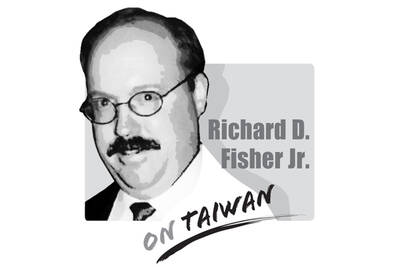The timing of a major missile test at Jioupeng (九鵬) base, Pingtung County, last Tuesday, could not have been more unusual, coming a little more than a week before Taipei and Beijing were to launch informal talks on a trade pact.
As it turns out, Taipei has since delayed the meeting until the end of the month, but the major artillery test — which reportedly included the highly sensitive Hsiung Feng-2E (HF-2E) surface-to-surface missile — does not appear to have been the cause. In fact, Beijing’s reaction, which one would have expected to be more strident than its opposition to a visit by Tibetan spiritual leader the Dalai Lama, was to say nothing whatsoever.
The military has stuck to protocol and released very little information about the missile test, only mentioning that a malfunction forced the test to be abandoned. The Presidential Office, meanwhile, said it regretted that news of the missile test had been leaked, with the Apple Daily going as far on Wednesday as to claim that President Ma Ying-jeou (馬英九) had said he was “very satisfied” with the test.
The fact that a missile test on this scale was held at all under a Ma administration that seeks, above all, better relations with China, and at a time when the two sides are on the brink of signing trade pacts, is itself striking. Failure or not, it is difficult to reconcile the timing with Ma’s “pragmatic” approach to cross-strait relations.
Though it is shrouded in secrecy, it is hard to imagine that the test would have gone unnoticed by the US and China. Despite Washington’s opposition to Taiwan’s acquiring or developing offensive weapons — which the HF-2E is — we can assume that the US military, which maintains close ties with the Taiwanese military apparatus, was informed beforehand, perhaps during the US-Taiwan Defense Industry Conference in Virginia late last month, or at the Transnational Security Cooperation course provided by the Asia-Pacific Center for Security Studies, a US-funded think tank based in Hawaii, earlier this year.
Such a test would also have been difficult to hide from China. Despite the remoteness of the base, which is located in the southeastern part of the country, such missiles would be picked up by Chinese radar.
The plan, therefore, appears to have been to keep the test secret and to avoid publicity lest it derail the careful, albeit precarious, balancing act engineered by Taipei, Beijing and Washington.
Which brings us to the most interesting side of the story: the source of the “leak,” which the Liberty Times (the Taipei Times’ sister paper) and the United Daily News referred to as a “reliable military source.”
While leaks are nothing new in the military, whistle-blowers usually make classified information public for a reason. In this case, given the sensitive nature and timing of the test, it is conceivable that the originator of the leak meant to put a spoke in the wheel of cross-strait negotiations, which have proceeded despite public apprehension. Had this gambit worked, Beijing could have reacted in anger and threatened to cancel the talks on a trade pact and an economic cooperation framework agreement. That it didn’t — in fact, Beijing said nothing at all about what should have been a “provocative” test — shows just how important those pacts are for China.
Many questions remain. Did the test really fail, as the military tells us, or is this information, which contradicts initial reports of a success, meant to downplay the importance of the test and ensure that cross-strait talks on economic liberalization can continue apace?
US President Donald Trump created some consternation in Taiwan last week when he told a news conference that a successful trade deal with China would help with “unification.” Although the People’s Republic of China has never ruled Taiwan, Trump’s language struck a raw nerve in Taiwan given his open siding with Russian President Vladimir Putin’s aggression seeking to “reunify” Ukraine and Russia. On earlier occasions, Trump has criticized Taiwan for “stealing” the US’ chip industry and for relying too much on the US for defense, ominously presaging a weakening of US support for Taiwan. However, further examination of Trump’s remarks in

As the Chinese Communist Party (CCP) and its People’s Liberation Army (PLA) reach the point of confidence that they can start and win a war to destroy the democratic culture on Taiwan, any future decision to do so may likely be directly affected by the CCP’s ability to promote wars on the Korean Peninsula, in Europe, or, as most recently, on the Indian subcontinent. It stands to reason that the Trump Administration’s success early on May 10 to convince India and Pakistan to deescalate their four-day conventional military conflict, assessed to be close to a nuclear weapons exchange, also served to
China on May 23, 1951, imposed the so-called “17-Point Agreement” to formally annex Tibet. In March, China in its 18th White Paper misleadingly said it laid “firm foundations for the region’s human rights cause.” The agreement is invalid in international law, because it was signed under threat. Ngapo Ngawang Jigme, head of the Tibetan delegation sent to China for peace negotiations, was not authorized to sign the agreement on behalf of the Tibetan government and the delegation was made to sign it under duress. After seven decades, Tibet remains intact and there is global outpouring of sympathy for Tibetans. This realization
After India’s punitive precision strikes targeting what New Delhi called nine terrorist sites inside Pakistan, reactions poured in from governments around the world. The Ministry of Foreign Affairs (MOFA) issued a statement on May 10, opposing terrorism and expressing concern about the growing tensions between India and Pakistan. The statement noticeably expressed support for the Indian government’s right to maintain its national security and act against terrorists. The ministry said that it “works closely with democratic partners worldwide in staunch opposition to international terrorism” and expressed “firm support for all legitimate and necessary actions taken by the government of India